Hello Kitty Turns 30 and Keeps on Growing
Back to Contents of Issue: September 2003
|
|
|
|
by Leo Lewis |
|
|
For many years Japan's industrial might has been judged by the world-beating strength of its manufacturers. From Honda Accords to NEC motherboards to PlayStation games consoles, Japan is hailed as a master of physical production.
But everyone forgets -- very often deliberately -- the deep Japanese pool of creativity and the country's prodigious talent for selling concepts around the world. It has always been easier to dismiss Japan's expertise as being the ability to perfect other nations' ideas and churn the finished articles out faster and better. People forget that Nintendo's Mario is recognized by more American children than Mickey Mouse, that Pokemon and Power Rangers have been the world's favorite toys for nearly a decade, and that for a period in the 90s, more than half the cartoons shown across Europe were translations of anime.
Sitting proudly atop this vast heap of creativity is Hello Kitty: a multi-media concept whose Zen-like simplicity makes her global success as baffling as it is staggering. There have been tweaks here and there over the years, but the basic idea has been kept surprisingly pure.
Behind her longevity lurks Perhaps the most impressive feature of Sanrio's feline phenomenon, however, is its extraordinary longevity. 2004 marks Kitty's 30th anniversary -- a milestone that the company will be celebrating all year in its own inimitable style.
In a rare interview with Sanrio's managing director, Susumu Emori, J@pan Inc was granted a fascinating glimpse behind the innocent face of its bewhiskered icon. What emerges is a picture of an unexpectedly nervous company -- every action it takes and every new product it comes up with seem to ooze with crisis mentality. The company has remained on top of the world, it seems, by assuming that obscurity is waiting around every corner. This is not a company at ease with the future. It fears the effects of the declining Japanese economy and is acutely aware of the innovation imperative. It has drawn up several new characters to join the Sanrio pantheon of Kitty, Batz Maru, Kero Kero and others, and is even considering, for the first time in company history, a magazine advertising campaign.
A multi-media concept whose As Emori explains, the key to beating a fickle market is to change even faster than taste. Every month, Sanrio brings out 500 new products and scraps the same number from the existing range. It has mastered the art of tailoring Kitty to changing seasons, changing fashions and changing interests. One of Emori's proudest coups is his new range of 200 different "localized" Kitty dolls. Each Japanese prefecture and major city now has its own version of the little cat representing that region's specialty: In Gunma she is peeking out of a cabbage, in Nagoya she is holding a chicken and in Okayama she is dressed like the legendary character Momotaro.
But even more important than innovation, says Emori, was the point -- reached at "some intangible moment in the mid 90s" when Kitty made the critical leap from being strictly a children's plaything to being a teenage craze and an adult obsession. Here even Emori admits that Kitty was blessed with two incredible strokes of luck that created what in Sanrio annals is known as the "Kitty Boom."
The second boost owed a lot to Sanrio's quick thinking. In 1996 -- just as the Print Club boom was really taking off -- Sanrio bought a large number of the machines and placed them strategically in their shops. As Emori explains, while groups of girls were waiting for their Print Club snaps to develop, they would walk around the shop and end up buying a strap for their mobile phone or some other piece of Kitty chic.
The leap from the kindergarten to the mainstream is now almost complete. Big Echo offers karaoke fans Kitty-themed rooms, Daiwa Hotels offer Kitty-suites and certain taxi firms have sent Kitty-Cabs out onto the roads of Kyoto and Tokyo.
That Sanrio faces innumerable challenges is not in question, but it is a company that has prevailed against extraordinary market odds at almost every turn in its history. Its head-office staff is 90 percent female, and as the young designers sit bashing out the 500 new products each month on pink Kitty computers, Sanrio can be fairly sure that it knows its market better than most. They do not need to bring in test audiences, because the designers themselves are the test audience. The toy industry may be a brutally adult place, but as far as Sanrio is concerned, Kitty hasn't yet used up even one of her nine lives. @ |
|
Note: The function "email this page" is currently not supported for this page.


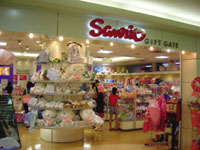 SEVENTEEN LINES. FOUR COLORS. No mouth. Multi-billion dollar global phenomenon. Is it possible that Hello Kitty is Japan's single greatest export?
SEVENTEEN LINES. FOUR COLORS. No mouth. Multi-billion dollar global phenomenon. Is it possible that Hello Kitty is Japan's single greatest export?
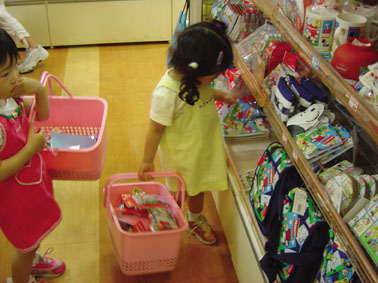 Kitty fully deserves her plaudits. Thirty years is a long reign by anyone's standards, but in a notoriously fickle industry in a notoriously fickle country like Japan, where young tastes shift more quickly than anywhere else on earth, it is especially worthy of note. All the more so because Kitty's fame has been achieved solely on the basis of her own existence. She is not a manga spin-off like Dragon Ball, a game spin-off like Pokemon or an anime spin-off like Gundam. The Cabbage Patch and My Little Pony crazes are consigned to history, but Kitty, for all her sweetness, is a ruthless survivor. Behind her longevity lurks a shrewd market understanding that companies everywhere should learn from, but it remains largely un-analyzed.
Kitty fully deserves her plaudits. Thirty years is a long reign by anyone's standards, but in a notoriously fickle industry in a notoriously fickle country like Japan, where young tastes shift more quickly than anywhere else on earth, it is especially worthy of note. All the more so because Kitty's fame has been achieved solely on the basis of her own existence. She is not a manga spin-off like Dragon Ball, a game spin-off like Pokemon or an anime spin-off like Gundam. The Cabbage Patch and My Little Pony crazes are consigned to history, but Kitty, for all her sweetness, is a ruthless survivor. Behind her longevity lurks a shrewd market understanding that companies everywhere should learn from, but it remains largely un-analyzed.
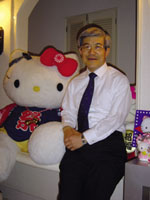 The point that Susumu Emori hammers home is that Sanrio has always been an intellectual property company -- and has been experiencing for years the trials that modern corporate titans are only just starting to come to terms with. Sanrio has branded shops across Japan and East Asia, and has attracted millions of visitors to its Kitty theme park, Puro Land. But its core asset remains the image of Kitty and its ability to dress her in an infinite number of different costumes and put that image on an infinite number of products. The toys, furry dolls, stationery, electrical equipment, stickers and phone straps are all produced in partnership with other Japanese companies. Bandai, Tomy and Takara make the toys, Matsushita makes the Hello Kitty toasters and taco-ball makers -- the list of Kitty affiliates goes on.
The point that Susumu Emori hammers home is that Sanrio has always been an intellectual property company -- and has been experiencing for years the trials that modern corporate titans are only just starting to come to terms with. Sanrio has branded shops across Japan and East Asia, and has attracted millions of visitors to its Kitty theme park, Puro Land. But its core asset remains the image of Kitty and its ability to dress her in an infinite number of different costumes and put that image on an infinite number of products. The toys, furry dolls, stationery, electrical equipment, stickers and phone straps are all produced in partnership with other Japanese companies. Bandai, Tomy and Takara make the toys, Matsushita makes the Hello Kitty toasters and taco-ball makers -- the list of Kitty affiliates goes on.
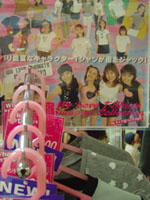 "Tourists go to a place, or people just pass through on business and they think to themselves: 'What would be the best souvenir?'" says Emori. "Kitty is such a strong brand that she will always make the best present -- the safest present because everyone loves her -- so by making her local, we were creating the perfect souvenir of every place you go."
"Tourists go to a place, or people just pass through on business and they think to themselves: 'What would be the best souvenir?'" says Emori. "Kitty is such a strong brand that she will always make the best present -- the safest present because everyone loves her -- so by making her local, we were creating the perfect souvenir of every place you go."
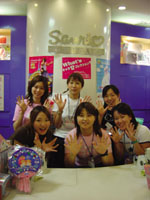 The first of these was thanks to a young Japanese starlet whose 15 minutes of fame put her on every TV show and every magazine cover in the mid 90s. Tomomi Kahara, as well as being a singer, was also a huge Kitty fan. She sported Kitty handbags in public and a variety of other accessories. Before long, every high-school girl in Japan -- already copying the Kahara "look" -- was buying up every piece of Kitty merchandise available in a mass effort to reflect the taste of their idol.
The first of these was thanks to a young Japanese starlet whose 15 minutes of fame put her on every TV show and every magazine cover in the mid 90s. Tomomi Kahara, as well as being a singer, was also a huge Kitty fan. She sported Kitty handbags in public and a variety of other accessories. Before long, every high-school girl in Japan -- already copying the Kahara "look" -- was buying up every piece of Kitty merchandise available in a mass effort to reflect the taste of their idol.



